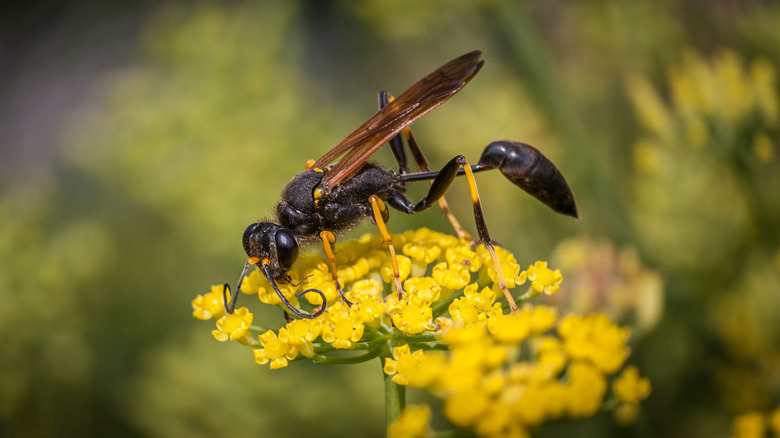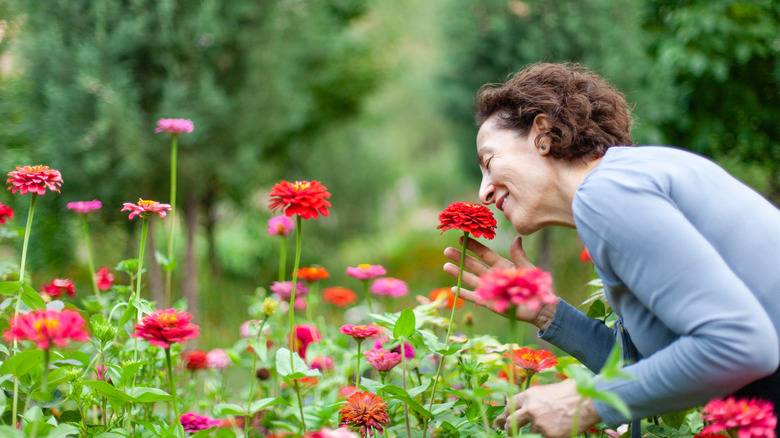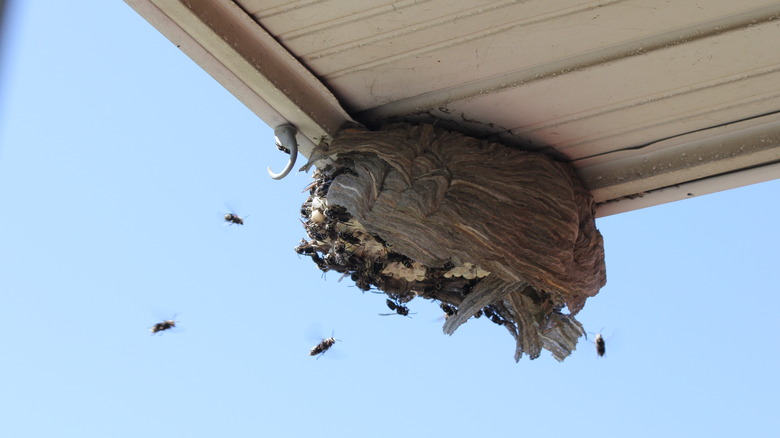If You Don't Want Wasps In Your Garden, Avoid Growing These Plants
Few outdoor insects are as loathsome as wasps. Because of their ability to sting repeatedly, having dozens of these insects around your property can ruin your time spent outdoors. You may not even want to work in your garden if they're buzzing around. Rather than trying to figure out ways to get rid of wasps, you may want to make sure that you don't have plants in your garden that are attracting them in the first place. Wasps fly around flowers, but these pests especially like sweet-smelling plants that also have flowers. This also explains why the sweet smell of apple cider vinegar tends to draw wasps into homemade traps successfully.
If you have sweet fennel in your garden, its tiny yellow flowers and sweet scent — which is similar to licorice — can attract wasps. Another sweet-smelling plant that has flowers is Queen Anne's lace, which has small white blossoms that resemble lace when seen from a distance. Both of these can grow to 4 feet or more in height, which means any of the pests that are attracted to these plants will be a few feet off the ground, closer to your head and face.
Another type of plant that draws wasps, especially in the early spring, is sedum. Because it blooms so early, these pests use it to collect nectar for food. Plants with names like Autumn Joy, Frosted Fire, Bertram Anderson, Ruby Glow, Matrona, and Dynomite are all part of the sedum family.
Other plants and trees that can draw wasps to your property
In addition to the sweet smells of certain plants and flowers, wasps often have an attraction to particular colors. They have a natural attraction to flowers that are yellow, white, blue, and purple. If you want to keep wasps away from your garden, primarily make use of red flowers on plants that have very little pollen.
Fruit trees and fruit-bearing plants will attract wasps, too. These pesky insects are drawn to the sweet and sugary taste of fruits. As they fall from the trees and become overripe, wasps become even more attracted to them, although they will crawl all over pieces that are still hanging in the tree, too. They may burrow into the pieces that are hanging on the tree, ruining any fruits you plan to harvest.
To make matters worse, wasps sometimes choose to build nests inside fruit trees, giving them easy access to these sources of food. When you're picking fruit, you could stumble onto one of these nests inadvertently, leaving you susceptible to potential stings from several insects at once. This is especially dangerous with wasps, because they can sting you multiple times in a row. They also might attack you while you're on a ladder trying to harvest, putting you in serious danger of a fall.
Other items around your home that could attract wasps
Although many different kinds of plants will attract wasps, these insects also may appear on your property and near your home for other reasons.
Wasps attempt to find food all year around. Because fruit is most common after it ripens in the autumn, these pests look for other sources of food at other times of the year. They will swarm around sources of food that you might leave out, such as uncovered dog food and cat food. They also may appear near your trash cans, especially if you do not completely tighten their lids, giving them an access point. If you have cans or glasses of soda pop or fruit juices open while you're working or enjoying time outdoors, wasps will investigate these liquids, drawn by the sweet smell.
Additionally, various structures on your property may prove hospitable to wasps. Most buildings have overhangs and eaves that protect the insects' nests from the weather. There isn't much you can do to make these areas less hospitable for the pests, other than removing nearby sources of food like uncovered garbage cans or pet food. However, you can eliminate other potential nesting sites. For example, if you have outbuildings or garages that have loose windows or cracks in doorways, wasps may go through these spaces and build their nests in a sheltered building. Block the holes and gaps to stop the wasps from going inside.


